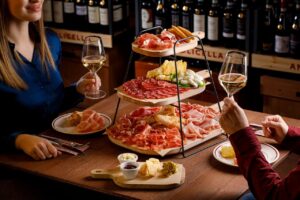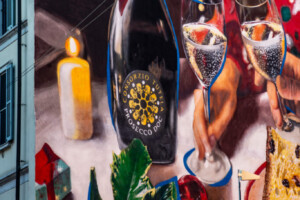Catering is a fundamental channel for Italian wine. However, the marriage between wineries and restaurants is not exactly smooth. And, indeed, more than one out of two wine producers say they are unhappy in this relationship. Further, in the near future, mainly due to the effects of the Pandemic, things will be even more complicated, since restaurateurs are saying that economic difficulties will still penalize wine sales, especially at higher prices. These are the results of the Wine Meridian /Witaly - Portions survey, signed by the journalist Fabio Piccoli and the critic Luigi Cremona, dedicated to the relationship between wine and restaurants. The survey was conducted following a very rough season, counting losses estimated at 17 million euros in the first semester 2020 – data from Fipe / Confcommercio- which noted that more than one in four restaurants have not yet reopened, and do not know if they will reopen in the near future.
“Wine adds culture and a space-time dimension to the cuisine of the restaurant. This is the reason why the combination of wine and catering is as natural as it is important”, emphasized Luigi Cremona at the presentation of the first results of the survey. “The kitchen lives in “zero” time and place. Wine broadens the horizon beyond the “here and now” to space; that is, the production areas, and to time; that is, the vintages and the producers’ stories, as well as its culture”.
This, then, is the sense of wine at table in catering, based on a bond that must be perfected to really create synergies so that growth will be interconnected. The crisis that the Covic-19 emergency provoked has pointed out HORECA’s (on trade market) importance for medium to high-end Italian wines, and the necessity to find new ways of relating to each other. This topic was discussed at the conference, "Wine and catering: seeking a new alliance" promoted by the Al Monte di Livio Winery, in the territory of the Breganze Hills.
“The HORECA channel is strategic for wine in Italy and around the world”, underlined Fabio Piccoli, director of Wine Meridian, “from an economic as well as image point of view. The reputation of wine companies is built above all here, even though the volumes are definitely lower than those in the large-scale retailers. The survey has no statistical value and does not claim to be exhaustive considering that, in Italy, there are 350.000 public businesses that fall within the HORECA channel”.
The survey does, however, have the merit of turning the spotlight on the relationship between the two categories and laying the foundation for comparing and negotiating common strategies. The initial results - on a sample of 100 participants for each sector, who were asked questions and asked to give preference to the pre-set answers - stigmatize already known critical issues, and according to Fabio Piccoli “bring out a desire to establish stronger, constructive and lasting relationships, starting from the unsatisfactory situation on both sides”. Fifty-five percent of the wine producers interviewed considered the relationship with the HORECA channel to be unsatisfactory and 25%, just acceptable. The discontent was attributed to wine lists concentrating on brands and denominations of the territory (35%) and the usual, most popular brands (25%).
“There are 46.000 companies that make wine in Italy offering from 5 to 15 wines each”, commented Piccoli. “It is difficult for restaurants to put all the wine companies on their lists. Besides, very large wine lists are scary to consumers. Restaurants have been criticized for years because they did not put local wines on their lists, and it is really good news that now they finally have. One wonders, instead, why the wine lists focus only on a few brands and whether the responsibilities lie only with restaurateurs”.
“It’s the laziness of the restaurateurs and the scarce creativity of the producers that contribute”, according to Cremona, “to determining this situation. If customers are not guided, the wine lists indicating well-known names facilitate the sale. In this period of the Covid-19 emergency, trust is essential. The chef that prepares dishes for us with his own hands, using fresh ingredients, preferably produced locally, gives us security, just like the well-known brands, if no one is there who knows about and can narrate wines of lesser-known companies. The presence of the chef in the dining room and the expertise of the wine producer reinforce trust.”
The majority of restaurateurs compile their wine lists according to their personal preferences (30%), as well as following advice and proposals from distributors and agents (30%); 20% are guided by a direct acquaintance with the company. 85% offer wines both according to the menu and the dining room staff’s advice. “Trusting, accepting advice and the importance of human relationships, of direct knowledge, has come back. The restaurateur feels honored”, Cremona commented,” when a wine producer visits him. And then there is the most important part, the dining room, because that is where the customer sits. We have gone from the very simplified description “white wine - red wine” to expert descriptions, which is very good, but we must not forget that the customer is looking for hospitality”.
Other issues identified in the relationship with the HORECA channel are not wanting to expand the offer (15%), getting to know the companies better (15%) and relying exclusively on distributors (5%). Finally, 5% of the respondents reported the limited winemaking culture on the part of restaurateurs, focusing on the dining room staff, though it takes a long time to build oenological competence.
Another critical point the wineries identified concerns the promotion of wines in restaurants and wine shops. 60% of the interviewees said they were never able to promote their wines (25% only rarely and 15% often), even though it was readily available (55%), like training the dining room staff was available as well as making just in time deliveries, thereby reducing their stocks (20%).
Companies invest heavily in fairs and events, but much less in promoting wine in the HORECA channel. The journalists Cremona and Piccoli both agreed that the HORECA channel is important and must have cultural content, specific formats and be frequented often, to overcome the difficulty of the small numbers of people it touches time to time. Therefore, markets that are not characterized by the offer of local wines are more interesting; i.e., where the comparison with other productions is open, such as Rome. “Promotion in catering”, specified Piccoli, “presumes that producers know the wine and maintain relationships with those who buy their wine, while often this does not happen. Two worlds that do not know each other cannot have a conversation”. As many as 60% of wine companies believe their commercial network is not adequate to better relate to the HORECA channel (30% fairly adequate and 10% adequate). The situation highlights that human resources are definitely crucial.
The approach and support that restaurateurs want from wine companies are reflected in the percentages of their responses, as they underline distance in interests and intentions. In 30% of cases they ask for greater availability to supply wines in promotion, and show a preference for companies that have distributors (more complete portfolios and fewer appointments). “To avoid the logic of selling at the price lever to which lesser-known wines are subjected”, commented Piccoli in this regard, “it is necessary to make one’s wines known as well as have good reviews from wine critics, even though the weight of the latter has decreased over the years”. The responses of producers and restaurateurs agree, instead on the need of greater availability for just in time deliveries (15%), a more direct relationship with the company and less with commercial intermediaries (15%), to get to know the companies better by scheduled visits (15%) to better understand their real identity (5%).
In terms of communication and promotion of wines, the majority of the respondents said they would like to have specifically designed proposals (30%) - and this would create the risk of seeing the wines on their lists also in large-scale retailing - request that companies send more customers to the premises (25%), and organize promotional initiatives in synergy with the restaurant (20%). “Initiatives should be planned and not impromptu”, Cremona emphasized, “and include some interesting sectors such as gourmet pizzerias that attract high numbers of focused customers, but which have been left in the hands of beer”.
From the observatory of the HORECA channel, the main difficulties customers find in choosing wine are linked to wine prices that are too high for their current economic means (25%), to the scarce wine culture (20%), to the changing lifestyles (never wine at lunch, for instance), the concentration of the usual well-known brands (20%), which the producers themselves complained about, the preference for "easier" drinks such as beer (10%) and the difficulty in understanding how to pair (5 %).
Finally, regarding future scenarios about what will change in post Covid-19, positions are divided among wine producers who think that there will be a diversification of distribution models (online, home delivery, direct sales, etc., 40%), those who believe that there will be new commercial relations and more remote relationships (30%), and a greater demand for sustainable wines (25%). Only 5% opted for a decrease in sales in the HORECA channel. The channel professionals, on their part, replied that cheaper wines will be consumed, 45%, Italian or local wines, 20%, while 15% think that there will be a demand for more organic wines and alternative drinks.
Copyright © 2000/2025
Contatti: info@winenews.it
Seguici anche su Twitter: @WineNewsIt
Seguici anche su Facebook: @winenewsit
Questo articolo è tratto dall'archivio di WineNews - Tutti i diritti riservati - Copyright © 2000/2025









































































































































































































